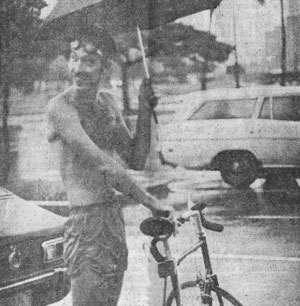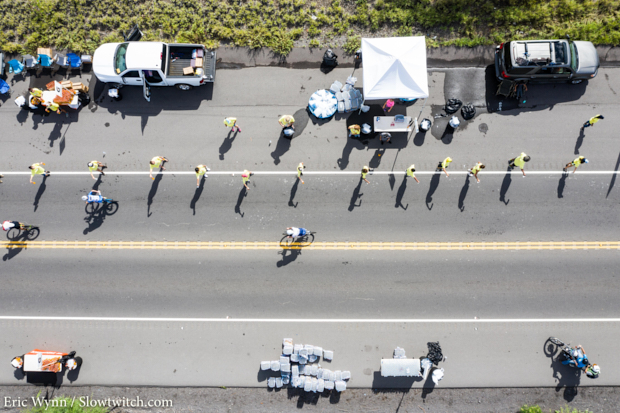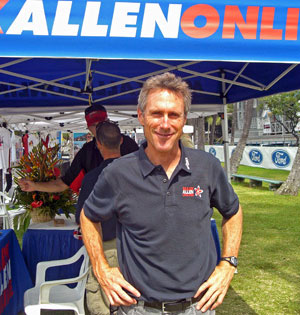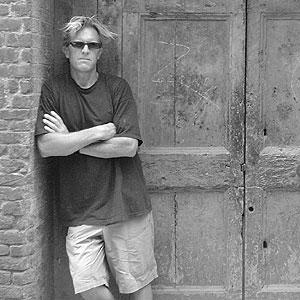Frank Day recalls Ironman 1978

15 people in the world can say that they have taken part in the very first Ironman triathlon in Hawaii, but only 12 can say that they finished the event. Slowtwitcher and Power Crank inventor Frank Day is one of these 12 finishers and he talked to Slowtwitch about that long day.
ST: How many Ironman races have you done and when was that?
Frank: I have done 2, 1978 and 1979. Well, if DNf-ing '79 counts as having done one.
ST: What or who actually inspired you to subject yourself to that challenge?
Frank: I heard about the race about two weeks before hand. I heard about it on one of those throw out things at the end of the news as I was listening to the radio on my commute home on my bike. I at first laughed about it but had time to think and when I got home called the station for the number to call again. I called the next day and it turned out to be John Collins. He actually worked in the building next to mine at Pearl Harbor naval Shipyard so I went over and talked to him. He pretty much talked me into it by simply saying words to the effect that "no one even knows if this can be done. You're in as good a shape as any of us, why don't you give it a try?" So, the next noon I went to the O' club pool and swam a mile to convince myself I wasn't going to down but once I did that I said, why not? I had done a couple of ultra marathons and I knew it could be done if one simply paced oneself properly. Wasn't sure if I had the base to do it but I knew someone could. I expected I could do it if I slowed down enough and was very smart.

ST: Can you describe your athletic background?
Frank: I rowed crew in college at the US Naval Academy but had pretty much been a weekend warrior until 1975 when I was a senior in medical school. My mentors in my cardiology rotation happened to run the cardiac rehab program and the Honolulu Marathon Clinic and they made us participate in both so we could understand how to help sedentary people and heart attack victims exercise safely, even to complete a marathon. In that 6 week rotation I got the running bug and determined I would compete in the Honolulu marathon 6 months later. I finished it in just under 4 hours, my goal. I then continued running and as I went to my internship I tried to find a house within a nice but not too long jogging distance. I wanted to be able to jog to work and keep up the running, as I knew I would not be able to add it on after my usual day. During that year my running pace going to work dropped at least a minute per mile. I also did two more marathons, the Marine Corps marathon and the Columbia Washington’s birthday marathon in Columbia, MD and also a few 10 km races during internship.
After the internship I got transferred back to Hawaii and was assigned as a doctor for a destroyer squadron. Luckily for my running, the entire squadron was going into the shipyard for overhaul so we never went to sea. My house though was too far for me to commute by running, so I bought a bike and started commuting via bike and ran at lunch. I kept pushing the running miles as my goal was to qualify for Boston. I needed a sub 3 to qualify and I went to the big Island Marathon to qualify. I failed miserably and was really feeling down. A friend suggested we go over and do the Run to the Sun. This is a 37 mile run from sea level to the top of Mt Haleakala (over 10k feet high) and I decided to do it just to help me feel better about myself. It was easier than I thought it would be, as I didn't try to race it. I then followed this up by doing a 50km run a while later at a huge ultra event and relay in Hawaii Kai that was an annual event. That was pretty much my background.
So, my aerobic athletic background was about 3 years long with only about 6 months of bike riding, with no ride longer than 10 miles, when I did the first IM.
ST: So you basically had a good base, but no specific training for that Ironman?
Frank: I basically swam that mile to convince myself I would not drown. Other than that – nada.

ST: Can you describe your race day in 1978?
Frank: Yes, although a lot of details have fallen through the cracks.
The water for the swim was perfectly flat. There were not even any ripples in the water. I don't remember how we handled the bikes because the swim start was at one end of Waikiki and the swim finish was at the other end, at Ft. DeRussy. We either dropped the bike off then went to the swim start or my handlers took it there after the swim start. Anyhow, my swim was pretty relaxed. We each had to have someone with a surfboard with us for a safety factor. As I remember there was supposedly one boat in the water just in case but I never saw it. We swam out beyond the reef, down the length of Waikiki and then back in at the opening of the reef near Ft. Derussy and back up to the beach. It was the course of the Waikiki Rough water swim.
Once out of the water I took a shower. Then I put on my running shoes and a running shirt and found my bike. My goal on the bike was to not blow it. Having never ridden more than 10 miles at any one time before my plan was to send my support crew about 6 miles ahead and when I saw them I would pull over and stop and assess how I was doing. Then, once I determined everything was ok, I would take off again and send them another 6 miles or so. I only remember a few specifics of that ride. First, at about mile 20 or so I passed Henry Forrest, who had passed me in transition when I was taking my shower. As I passed him we chatted for a while and I remember him specifically asking me "do you know how to shift this thing?" He was one of the people who had purchased his bike the week before the race. He had ZERO bike experience. I just thought he was toast. He was not. He was like the little engine that could. Every time I stopped at those 6 mile intervals, about the time I started off again, here he was coming. What I learned from that was how much stopping hurts your average speed. The next thing I remember was what I did for nutrition. I had heard that the Tour de France people used oranges and bananas during the race so that is what I had. I took what I felt I needed at each stop. Since I stopped so often I didn't feel pushed to eat a lot at each stop. Next, I remember climbing the hills to the center of the Island and the pineapple fields. I thought those hills would never end. But they did and then it was mostly downhill to Pearl Harbor. After that it was only another 5 miles or so to the Aloha Tower, the start of the run.
I remember pulling into the parking lot there and seeing Judy Collins who took down my time. I got a new set of handlers there and my friend Charles Woods and I started out on the run. I remember being just amazed at how well I felt. I started out and it seemed like a training run. Jogging along at 7:30 miles. Seemed like it would be a piece of cake until about mile 10 when I just ran out of energy. I couldn't run more than 10 steps at a time. At about 12 miles on the course at Hawaii Kai there was a McDonalds. I went inside and sat down with my handlers and had the largest Coke they had. Henry Forrest, the little engine that could on the bike course, passed me while I was in the McDonald's. After I rejuvenated for about 30 minutes I went out again and was able to run for about 4 miles (probably as many calories as was in that coke) then basically walked in.
When I got to the finish line there was no one there. It was not even marked, as we all knew where it was as it was the finish line of the Honolulu marathon and we had all done that . Anyhow, when I crossed the finish line I noted my time (about 16:30) and then climbed in my car and went home to go to bed.
The next day we all met at John Collins’ house to compare notes and to silkscreen our own finisher’s tee shirts (we provided the shirts). As I remember the "entry fee" was 5 dollars to cover expenses and I think we got 3 dollars back from John.








Start the discussion at forum.slowtwitch.com